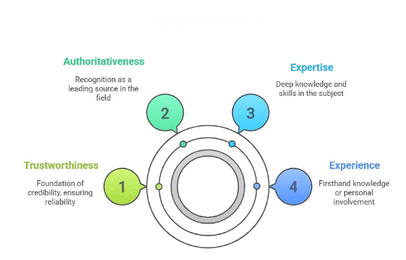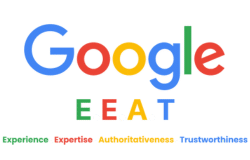Key Points
- E-E-A-T Defined: It stands for Experience, Expertise, Authoritativeness, and Trustworthiness. These factors influence how Google evaluates the quality of content.
- Growing Importance: In 2025, it seems likely that E-E-A-T will be critical due to the rise of AI-generated content, which may lack human insight.
- SEO Impact: Content with strong E-E-A-T tends to rank higher, especially for topics like health or finance.
- No Controversy: The concept is widely accepted in SEO, though applying it effectively can be complex.
What is E-E-A-T?

E-E-A-T refers to a framework Google uses to assess whether online content is reliable and valuable, particularly for sensitive topics like health, finance, or safety, often called YMYL (Your Money or Your Life). It emphasises four qualities: firsthand experience, deep knowledge, recognised authority, and trustworthiness. For example, a blog post about managing diabetes written by a doctor who treats patients is more likely to align with E-E-A-T than one by a general writer.
Why It’s Crucial in 2025
The evidence leans toward E-E-A-T being more important now because of the explosion of AI-generated content. Tools like Chatgpt can produce articles quickly, but they often miss the mark on personal experience or verified expertise. Google’s algorithms appear to prioritise human-created content that demonstrates these qualities, especially after updates like the one in March 2025, which favoured human-written material over automated content.
How to Apply E-E-A-T
To create content that aligns with E-E-A-T, focus on showcasing your experience, citing credible sources, and building trust. For instance, if you’re writing about fitness, share your workout journey or quote a certified trainer. Simple steps like adding an “About Us” page or using secure website connections (HTTPS) can also boost trustworthiness.
Why E-E-A-T Improtant
Hey there! If you’re into creating content—whether it’s a blog, a website, or even posts on X—you’ve probably heard about SEO (Search Engine Optimisation). It’s the magic that helps your content reach the right people. But in growing AI trends, there’s a concept that’s become super important for anyone putting stuff online: E-E-A-T. Nope, it’s not a new snack (though that’d be awesome). It’s a set of guidelines that can make or break your content’s success.
What is E-E-A-T?

E-E-A-T stands for Experience, Expertise, Authority, and Trust. It’s how Google decides if your content is legitimate, especially for topics that matter, like health, money, or safety. These topics are known as YMYL (Your Money or Your Life) because they can significantly impact people’s well-being. Imagine you’re Googling “How to save for college” or “Is this rash serious?” You want answers from someone experienced and knowledgeable, right? That’s what E-E-A-T is all about.
Here’s a quick breakdown of each part:

Why E-E-A-T Matters More Than Ever in 2025
In 2025, the internet will be like a giant library with endless books—some amazing, some not so much. With AI tools churning out content faster than you can say “blog post,” there’s a ton of info out there, but not all of it is trustworthy. AI can write articles in seconds, but it doesn’t have real-world experience or the deep expertise humans bring. For example, an AI might write a guide to hiking Mount Everest without ever setting foot on a trail, while a human climber can share what it’s really like.
Google has been stepping up its game to make sure you find reliable content. Back in December 2022, they added the extra “E” for Experience to the original E-A-T (Expertise, Authority, Trust), showing that firsthand knowledge is a big deal (Google Ratings Guidelines). In March 2025, Google rolled out a core update that seems to favour human-written content over stuff created by automated systems (March Core Update). This means if you want your content to show up high in search results, it needs to scream “I’m legit!” through E-E-A-T.
Plus, people are pickier now. Only about 14% of consumers trust brand claims as much as user reviews (Local Business Survey), so showing real experience and credibility is key to winning over your audience.
The Four Pillars of E-E-A-T
Let’s dive into each part of E-E-A-T to see why they’re so important and how they work in real life.
Experience

This is about having been there and done that. If you’re writing about something, it’s way more convincing if you’ve lived it. For example:
- A food blogger who’s cooked the recipes they share.
- A student writing about surviving finals week because, well, they’ve been through it.
- Experience adds a personal touch that makes your content more relatable and believable.
Expertise

This is where your knowledge and skills shine. If you’re tackling a complex topic, it helps to have some credentials or a solid background. Think:
- A financial planner giving tips on budgeting.
- A coder explaining how to debug Python like a pro.
- Expertise shows you’re not just winging it—you’ve got the know-how to back it up.
Authority

This is about being the source people turn to. Big names like the Financial Times for money news or Healthline for wellness tips have authority because they’re trusted in their fields. For your content, this means creating in-depth, well-researched stuff that others respect and maybe even link to.
Trust

Nobody wants to read something sketchy. Trustworthiness is about being honest and reliable. Your website should have:
- A secure connection (HTTPS).
- Include clear contact info so people can reach you.
- An “About Us” page that narrates the journey of our brand.
- If your audience trusts you, they’re more likely to stick around and share your content.
How to Make Your Content E-E-A-T-Friendly

So, how do you do E-E-A-T? Here are 11 practical tips to level up your content game, inspired by experts (Backlinko E-E-A-T Guide):
- Use Real Experience – Write about what you know or team up with someone who’s been there. If you’re blogging about skateboarding, share your tricks or quote a pro skater.
- Offer Something New – Don’t just repeat what’s already online. Add unique insights, like your own data or a fresh take. For example, if you’re writing about study hacks, share a method you’ve tested yourself.
- Build a Solid Rep – Get reviews on platforms like Google Business Profile or Trustpilot. Good feedback from real people makes you look trustworthy.
- Show Off Your Authors – Create author pages that highlight their background and skills. If you’re writing about tech, let readers know you’ve built apps or studied computer science.
- Get Press Mentions – Being featured in news outlets or blogs boosts your authority. It’s like getting a shout-out from someone everyone respects.
- Upgrade your About Us Page – Share your story, introduce your team, and mention any awards. It’s as if you’re saying to your audience, “We’re genuine people you can trust.”
- Cover the Basics – Have clear terms of service, a privacy policy, and contact info. These are small details that can have a significant impact.
- Back-Up Your Claims – Link to studies, research, or data. If you say “exercise boosts mood,” cite a study to prove it.
- Use Your Photos and Vids – Skip stock photos and use your own images or videos. A selfie from a hiking trail feels way more real than a generic mountain pic.
- Keep It Fresh – Update your content regularly and show the last updated date. Old info can make you look out of touch.
- Chat with Your Audience – Reply to comments or messages. It shows you’re engaged and care about what people think.
Why E-E-A-T Boosts Your SEO

Here’s the deal: Google wants to show users the best content. If your stuff checks all the E-E-A-T boxes, it’s more likely to rank higher in search results. That means more clicks, more readers, and maybe even more followers or customers. High E-E-A-T content tends to keep people on your page longer, and they’re more likely to share it, which Google loves (Moz E-E-A-T Guide).
On the flip side, if your content feels thin or untrustworthy, it might get buried under better options. E-E-A-T is non-negotiable for YMYL topics like finance or health because wrong info could cause real harm.
Wrapping It Up
In 2025, E-E-A-T is like the golden rule for content creators. With AI flooding the internet and Google cracking down on low-quality stuff, showing experience, expertise, authority, and trust is more crucial than ever. It’s not just about writing something cool—it’s about proving you’re a reliable source people can count on.
So, take a peek at your content. Does it show what you know and who you are? Is your site easy to trust? If not, try some of these tips. Whether you’re blogging about fashion, tech, or life hacks, E-E-A-T can help you stand out and connect with your audience. Keep it real, and you’ll be golden.



Add a Comment